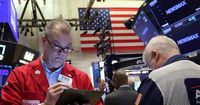Global stock markets faced a significant downturn following President Donald Trump’s announcement of sweeping new tariffs on Wednesday, April 2, 2025, which are anticipated to raise prices and hinder growth both in the U.S. and abroad. The news sent shockwaves through the financial world, resulting in the S&P 500 experiencing its worst day since the onset of the Covid-19 pandemic in 2020.
On Thursday, April 3, 2025, the S&P 500 plummeted 4.8%, erasing approximately $2 trillion in market value. The Dow Jones Industrial Average fell by about 4%, while the Nasdaq Composite tumbled roughly 6%. These losses marked the largest daily percentage drops for major U.S. stock indexes since June 2020, as investors grappled with the implications of the tariffs.
The tariffs, which include a minimum 10% levy on global imports, are part of Trump’s strategy to boost U.S. manufacturing and federal revenues. However, the announcement has raised concerns about inflation and the potential for a global trade war, with China facing an aggregate 54% tariff and the European Union a 20% duty. In response, both China and the EU vowed to retaliate, with French President Emmanuel Macron urging European firms to suspend planned investments in the U.S.
Market analysts are deeply concerned about the potential consequences of these tariffs on global trade. The World Trade Organization estimated that trade volumes could shrink by 1% this year, exacerbating fears of an economic slowdown. As of Friday, April 4, 2025, Japan’s Nikkei 225 index dropped 2.7%, and Australia’s ASX 200 fell by 1.6%, reflecting the widespread impact of the tariffs across the Asia-Pacific region.
Traders are particularly anxious about the inflationary effects of the tariffs, which could drive prices up significantly. UBS analysts warned that if the tariffs become permanent, U.S. inflation could surge to 5%. The fear is that rising prices could prompt the Federal Reserve to increase interest rates, further stifling economic growth and potentially leading to stagflation—a scenario characterized by stagnant growth and rising prices.
As stocks continued to tumble, gold prices initially soared to a record high of $3,167.57 an ounce before retreating. The dollar also weakened against other currencies, with investors flocking to safe-haven assets like bonds. The benchmark U.S. 10-year Treasury note yield fell to 4.004%, its lowest since November 2024.
In the wake of the tariffs, major companies like Nike, Apple, and Target saw their stock prices plummet by more than 9%. Nike’s shares were down 14%, while Apple and Target fell roughly 9% and 10%, respectively. The automotive industry was also hit hard, with Stellantis temporarily halting production at plants in Mexico and Canada, resulting in layoffs for 900 employees at five U.S. plants.
In Europe, the market sentiment mirrored that of the U.S., with the pan-European STOXX 600 index falling by 2.57%. Shares of Adidas and Puma dropped significantly, while luxury goods firms like LVMH and Pandora also faced declines. The market turmoil has led to predictions of a prolonged period of volatility, as investors remain cautious amid uncertainty surrounding the tariffs and potential retaliatory measures.
Despite the grim outlook, Trump remains optimistic, asserting that the U.S. economy will “boom” as a result of the tariffs. He likened the situation to a surgical operation, stating, “I think it’s going very well. It was an operation like when a patient gets operated on, and it’s a big thing. I said this would exactly be the way it is.” However, many analysts are skeptical, arguing that the immediate impacts of the tariffs are likely to be detrimental.
Critics of the tariffs argue that the short-term economic pain may outweigh any long-term benefits, as American exporters could find themselves in a precarious position if global economic growth falters. The fear is that escalating trade tensions could negate any perceived advantages of the tariffs. The ongoing sell-off in the stock market, which has been ongoing since mid-February amid trade war fears, underscores the growing anxiety among investors.
As the situation unfolds, the potential for retaliatory measures from other countries looms large. Canada’s Prime Minister Mark Carney announced that Canada would impose a 25% levy on vehicles imported from the U.S., further escalating tensions. With the stakes so high, the global economy remains on edge, and the outlook for the coming months remains uncertain.
In the context of these developments, the conversation around U.S. manufacturing has intensified. Supporters of the tariffs argue that they will ultimately lead to companies relocating production back to the U.S., which they believe will revitalize American manufacturing. However, whether this strategy will yield the desired economic benefits remains a contentious debate.
As markets continue to react to the unfolding trade saga, it is evident that the ramifications of Trump’s tariff announcement are being felt far beyond U.S. borders. Investors and analysts alike are closely monitoring developments, with the hope that meaningful dialogue between global leaders might pave the way for a resolution to the escalating trade tensions.
For now, the financial landscape remains turbulent, and the path forward is fraught with uncertainty. The unfolding trade war, characterized by rising tariffs and retaliatory measures, has the potential to reshape the global economic order, and all eyes will be on how this situation develops in the coming weeks.





